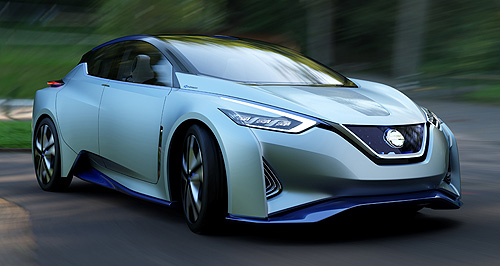Make / Model Search
Future models - Nissan - IDSTokyo show: Nissan unveils self-drive EVNext Leaf EV in frame as Nissan previews self-driving future with IDS conceptGallery Click to see larger images 28 Oct 2015 By TIM ROBSON NISSAN has previewed a self-driving, zero-emissions future for everyday motorists with the unveiling of the IDS (or Intelligent Drive System) autonomous electric vehicle in the form of a relatively real-world three-door hatchback. The star attraction on Nissan’s stand at the Tokyo motor show this morning, the IDS concept is the clearest indication yet that the Japanese auto giant is still chasing its zero-emissions/zero-fatalities goal for 2020, instigated by Nissan CEO Carlos Ghosn in 2013. It also offers a big visual clue as to the appearance of the next Leaf, although Mr Ghosn stopped short of confirming that the concept previews Nissan’s second-generation global electric car, which is due for replacement in the next year or so. The compact four-seater concept uses advanced artificial intelligence systems in conjunction with already-existing technologies like radar cruise control and lane departure control, combining these with a powerful electric drivetrain designed for urban applications. The IDS also looks to the internet to keep itself up to date with current traffic, navigation and weather data on the run, adjusting its driving route where necessary. A mode known as Piloted Drive can mimic the user’s pre-learned driving habits and patterns autonomously, relying on feedback from a bank of sensors and a camera array. The IDS will even replicate the braking force and cornering speeds displayed by the previous driver. While the driver can resume full manual control, the Piloted Drive systems are constantly engaged, assisting when required to prevent crashes. An automated parking function can be accessed via a smartphone or tablet, and the IDS also sports an inductive charging system. Inside, the IDS’s steering wheel retracts when the vehicle is in autonomous mode, replaced by an additional flat screen display. All four seats also rotate slightly inwards when the IDS is driving itself, creating what Nissan calls a “living room atmosphere”. The seats (and steering wheel) return to normal positions in manual mode. “A key point behind the Nissan IDS concept is communication,” said Nissan design director Mitsunori Morita. “For autonomous drive to become reality, as a society we have to consider not only communication between car and driver but also between cars and people. The Nissan IDS concept’s design embodies Nissan’s vision of autonomous drive as expressed in the phrase: together, we ride.” Based around a carbon body and chassis, the IDS runs a 60kWh battery pack and has a relatively low 1380mm roofline. Combined with tall, narrow tyres, this reduces the frontal area of the vehicle and maximises its aerodynamic profile. Nissan says that all aspects of the IDS’s powertrain, including batteries, motors and inverters, have been reworked, allowing it to drive for “long distances”, as the company puts it. No performance figures or weights were given, but the IDS’s battery pack is twice as big as the current Leaf, which would give it a theoretical range that is closing in on 500km. An LED light line runs around the entire car, illuminating to show that it is aware of pedestrians or cyclists. An external display can also show messages to passers-by, like ‘after you’ at a pedestrian crossing.  Read more11th of September 2015  Nissan boosts Leaf battery range to 250kmSlow EV uptake in Oz means Nissan Leaf’s bigger battery unlikely to arrive soonAll future modelsMotor industry news |
Click to shareNissan modelsResearch Nissan All future modelsMotor industry news |



























 Alfa Romeo
Alfa Romeo Abarth
Abarth Audi
Audi Aston Martin
Aston Martin BMW
BMW Bentley
Bentley Ferrari
Ferrari Chevrolet
Chevrolet Ford
Ford Fiat
Fiat GWM
GWM Foton
Foton Hyundai
Hyundai Honda
Honda Jaguar
Jaguar Isuzu
Isuzu Kia
Kia Jeep
Jeep Land Rover
Land Rover Lamborghini
Lamborghini Maserati
Maserati Lexus
Lexus McLaren
McLaren Mazda
Mazda Mercedes-Benz
Mercedes-Benz Mitsubishi
Mitsubishi Mini
Mini Peugeot
Peugeot Nissan
Nissan Ram
Ram Porsche
Porsche Rolls-Royce
Rolls-Royce Smart
Smart Skoda
Skoda Suzuki
Suzuki Subaru
Subaru Toyota
Toyota Tesla
Tesla Volvo
Volvo Zeekr
Zeekr







Facebook Twitter Instagram